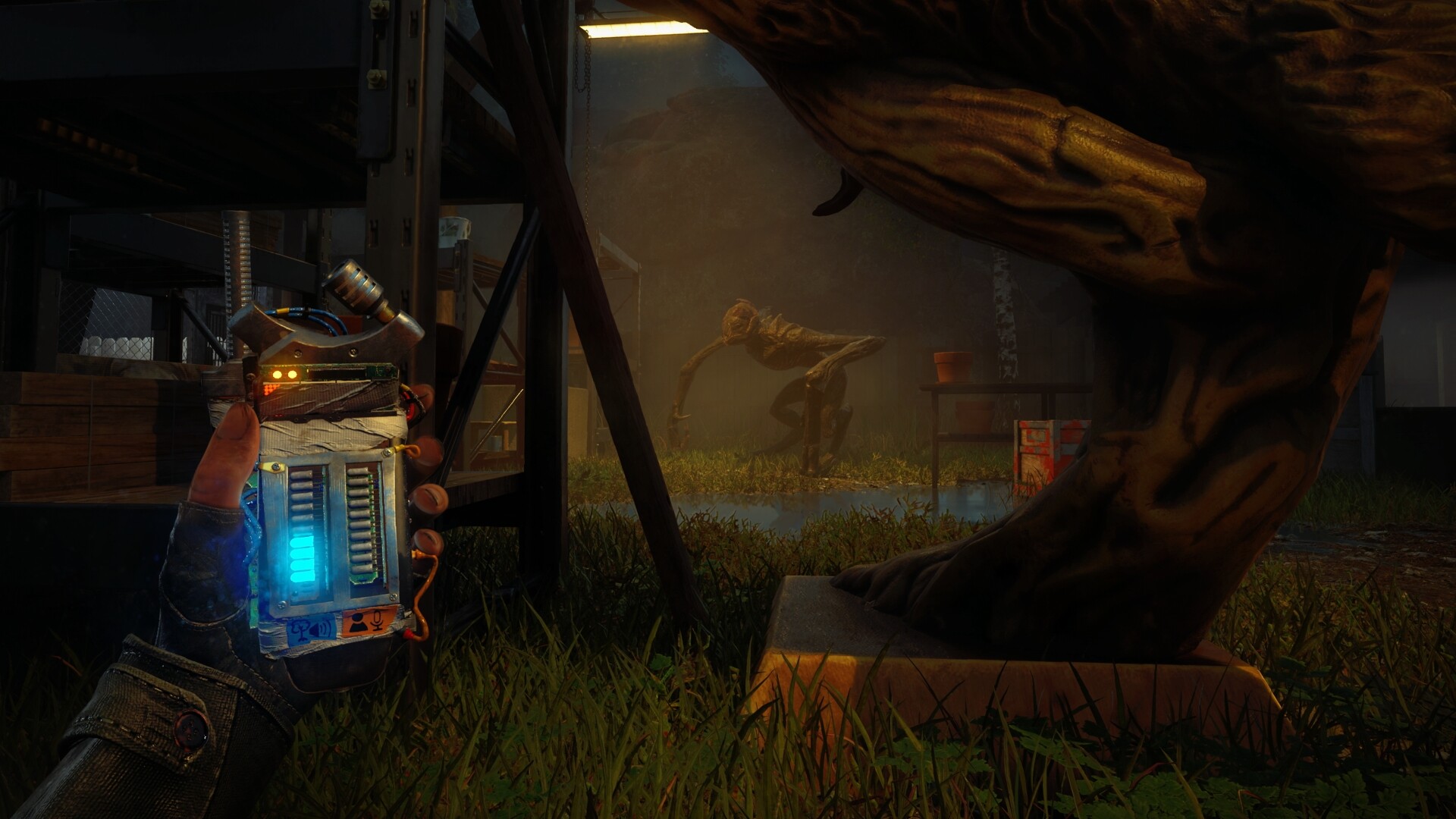
A Quiet Place: The Road Ahead is out today, and though it might not be as high-profile of a release as something like a new Resident Evil or Silent Hill, it’s certainly a game that many horror fans have had their eye on. Set in the Quiet Place movies’ universe, the first-person horror adventure title is touting intense stealth mechanics in an experience pulling from some of the most atmospheric gaming experiences out there. Prior to the game’s release, we were recently able to send across some of our most burning questions about the game to its development team at Stormind Games, in the process learning more about its unique stealth system, the games it has drawn inspiration from, and more. You can read our full interview below.
NOTE: This interview was conducted prior to the game’s launch.
"We designed the stealth gameplay in A Quiet Place: The Road Ahead to be deep and strategic, without becoming overly complex or frustrating."
With The Road Ahead being positioned as a prequel, how deeply will it be tied to the movies in terms of its story? For instance, what should players expect in terms of connections, easter eggs, and the like?
Luca Esposito (Senior Narrative Designer): Rather than being a prequel, The Road Ahead is a story set within the narrative universe of A Quiet Place, taking place between Day One and the start of the first film. While it introduces a new cast of characters, the story we tell is connected to the films only through its themes and scenarios. There are no direct references to the characters or events from the movies, but players will recognize familiar survival situations and dynamics from the cinematic saga.
Given the premise of the game and the universe it is set in, stealth is obviously going to be a big part of the experience. How nuanced and mechanically dense should players expect the gameplay experience to be in that department?
Manuel Moavero (Lead Game Designer): We designed the stealth gameplay in A Quiet Place: The Road Ahead to be deep and strategic, without becoming overly complex or frustrating. Managing sound is the heart of the game, and players have to be very mindful of the noise they produce, from simple everyday actions like walking or opening doors to more complex interactions with the environment, like throwing objects or moving on noisy surfaces.
Every surface has its own “sound profile,” which means that walking on sand is far less risky than walking on rusted metal, which can quickly attract the attention of the creatures. This system adds a layer of depth to the stealth mechanics, requiring players to carefully plan every move.
Additionally, the phonometer plays a crucial role: it’s a tool that measures noise and provides visual feedback to help players understand how much they are risking. The ability to mask sounds through environmental sources like water or wind offers further strategic opportunities.
In short, the stealth system is nuanced, and the design is intended to be accessible and rewarding, allowing players to use the environment to survive rather than focusing on overly complex mechanics.
What can you tell us about the game’s progression mechanics?
Moavero: Progression in A Quiet Place: The Road Ahead is not based on a traditional system of upgrading the protagonist’s abilities, but on a gradual evolution of resources, tools, and solutions available to the player. Alex, the protagonist, will face increasingly complex and dangerous situations, and to do so, she will have to use new tools and interact with more complicated environments.
Each level introduces new mechanics, such as flares, sandbags, or devices like fuses and valves. These tools not only expand the player’s tactical options but are essential for solving puzzles and tackling challenges that arise along the way.
Despite the absence of a traditional progression system, the variety of solutions and the increasing difficulty of the situations make the experience dynamic and stimulating. The constant and unpredictable presence of the creatures adds another layer of pressure, forcing players to rethink their strategies continuously. In some moments of the game, players will also have to exploit the creatures’ sensitivity to electronic devices against them, making the gameplay even more interesting and varied.
"There were moments during development when we discussed whether to lean more towards survival horror. Tension and fear are fundamental elements in A Quiet Place: The Road Ahead, and the constant risk of death is present at every moment, but we wanted to maintain a balance between the horror experience and the adventure aspect characteristic of the movies."
A Quiet Place: The Road Ahead is billed as a horror adventure game, but were there ever conversations during development to lean more into the survival horror direction?
Moavero: Yes, there were moments during development when we discussed whether to lean more towards survival horror. Tension and fear are fundamental elements in A Quiet Place: The Road Ahead, and the constant risk of death is present at every moment, but we wanted to maintain a balance between the horror experience and the adventure aspect characteristic of the movies.
While the game includes survival mechanics, such as managing noise and needing to be cautious with every single movement, we didn’t want to focus too much on the more typical aspects of survival horror, such as extreme resource scarcity. Our main goal was to create an immersive but accessible experience that offered a high level of tension and fear without ever becoming too punishing for players who didn’t manage their inventory perfectly.
In the end, we decided to maintain an approach that mixed adventure, fear, and ingenuity, creating an experience that was both engaging and challenging. The focus on sound and the need to remain silent, rather than confronting the creatures directly, is what sets our game apart, and this influenced our decision to stray a bit from the conventions of traditional survival horror.
Do you think the resurgence of horror games in the last few years has allowed developers the opportunity to experiment more with the tone and format of horror games they put out? What are some of the games that you have looked to for inspiration during The Road Ahead’s development?
Moavero: Absolutely: the resurgence of horror games in recent years has allowed developers to explore new ideas and approaches to the genre.
With the evolution of technology and innovation in gameplay mechanics, audiences have become more open to different experiences, allowing creators to push the boundaries of traditional horror games. Today, we see a greater variety, from more action-oriented games to psychological survival horror and more atmospheric horror, as in the case of A Quiet Place: The Road Ahead.
During development, we were inspired by several games that managed to blend fear and atmosphere in unique ways. Alien: Isolation was our main inspiration, particularly for its management of tension and the feeling of being hunted by an enemy you can’t confront directly. The fear stemming from the constant invisible threat is something we wanted to capture in A Quiet Place: The Road Ahead, but with the unique sound-based mechanic.
The Last of Us was a major reference for the way it creates tension through resource management and interaction with the environment. Amnesia influenced our thinking on how to create fear without necessarily showing enemies at every moment, instead playing on the sense of vulnerability and isolation.
We also drew inspiration from games like Splinter Cell: Chaos Theory, for the depth of its stealth mechanics, and Thief, for the importance of environment and sound in determining survival. Each of these games taught us something important about how to balance tension, exploration, and danger in a way that immerses the player in an intense horror experience without being too punishing.
In the end, the variety and success of recent horror games gave us the freedom to experiment and innovate, allowing us to explore a more atmospheric, sound-based direction while keeping the core of the horror genre intact.
Roughly how long will an average playthrough of the game be?
Alessio Alfonsi (Producer): The experience lasts from 8 to 12 hours, depending on the difficulty chosen and, above all, how much you want to complete the game 100% to collect all the collectibles and unlock the extras from the main menu. Furthermore, the duration can also increase thanks to additional runs, when a player decides to try the experience again at a higher difficulty.
"Alien: Isolation was our main inspiration, particularly for its management of tension and the feeling of being hunted by an enemy you can’t confront directly."
Given that you have experience working with all the current-gen consoles, I was hoping to pick your brain on some of the differences between them. For instance, where their GPUs are concerned, the PS5 clocks in at 10.28 teraflops, behind the Xbox Series X’s 12 teraflops. In real terms, however, how much of an impact does that difference have during development?
The difference in teraflops between the PS5 and Xbox Series X is real in terms of raw computing power, but during development, the actual impact often depends on how well-optimized the game is. In many cases, both systems can achieve similar results since development tools and middleware are designed to maximize the hardware potential of each console. The difference in GPU performance becomes more noticeable in scenarios requiring heavy rendering. However, with good optimization, these differences are often near imperceptible to the end user.
The PS5 features an incredibly fast SSD with 5.5GB/s raw bandwidth. How can developers take advantage of this, and how does this compare to the Xbox Series X’s 2.4GB/s raw bandwidth?
The PS5’s incredibly fast SSD allows for much quicker loading of game levels and sections, reducing wait times and the need for traditional loading screens. This is especially beneficial for continuous asset streaming. For developers, it means we can design levels with greater fluidity and fewer interruptions. The Xbox Series X has a slower raw SSD speed, but it still offers excellent performance due to internal optimizations and its Velocity Architecture support.
Both the PS5 and Xbox Series X boast Zen 2 CPUs, but there is a difference in the processors of both consoles. The Xbox Series X features 8x Zen 2 Cores at 3.8GHz, whereas the PS5 features 8x Zen 2 Cores at 3.5GHz. Your thoughts on this difference?
The clock speed difference between the processors of the two consoles is marginal and rarely affects the gaming experience significantly. Rather, it depends on how each console manages cooling and power balancing. Generally, development on both platforms requires specific optimizations, but the CPU difference doesn’t majorly impact the game.
The Xbox Series S features lesser hardware compared to Xbox Series and Microsoft is pushing it as a 1440p/60 FPS console. Have you faced any problem while developing for it?
The Xbox Series S is more limited in hardware compared to the Series X, especially in terms of GPU and memory. However, it’s possible to optimize the game effectively. There are technical challenges when developing very ambitious or visually complex games, which might require compromises like reducing texture quality or using a more aggressive dynamic resolution to maintain a smooth experience.
"The variety and success of recent horror games gave us the freedom to experiment and innovate, allowing us to explore a more atmospheric, sound-based direction while keeping the core of the horror genre intact."
What frame rate and resolution will the game target on the PS5 and Xbox Series X/S?
Our goal is to offer two modes on both PS5 and Xbox Series X: a Performance Mode targeting 60 FPS at 1440p with dynamic resolution scaling, and a Quality Mode targeting 30 FPS at 4K with dynamic resolution scaling. On the Series S, we’re aiming at 1440p at 30 FPS with dynamic resolution.


















